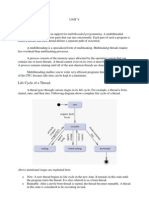0% found this document useful (0 votes)
5 views14 pagesUnit 7 - Threads
This document provides an overview of multithreading in Java, explaining its features, thread states, and methods for creating threads using the Thread class and Runnable interface. It also covers thread management concepts such as stopping, blocking, priorities, synchronization, inter-thread communication, and deadlock. Various code examples illustrate these concepts, demonstrating how threads can run concurrently and the importance of managing shared resources.
Uploaded by
sujal MunikarCopyright
© © All Rights Reserved
We take content rights seriously. If you suspect this is your content, claim it here.
Available Formats
Download as PDF, TXT or read online on Scribd
0% found this document useful (0 votes)
5 views14 pagesUnit 7 - Threads
This document provides an overview of multithreading in Java, explaining its features, thread states, and methods for creating threads using the Thread class and Runnable interface. It also covers thread management concepts such as stopping, blocking, priorities, synchronization, inter-thread communication, and deadlock. Various code examples illustrate these concepts, demonstrating how threads can run concurrently and the importance of managing shared resources.
Uploaded by
sujal MunikarCopyright
© © All Rights Reserved
We take content rights seriously. If you suspect this is your content, claim it here.
Available Formats
Download as PDF, TXT or read online on Scribd
/ 14























































































